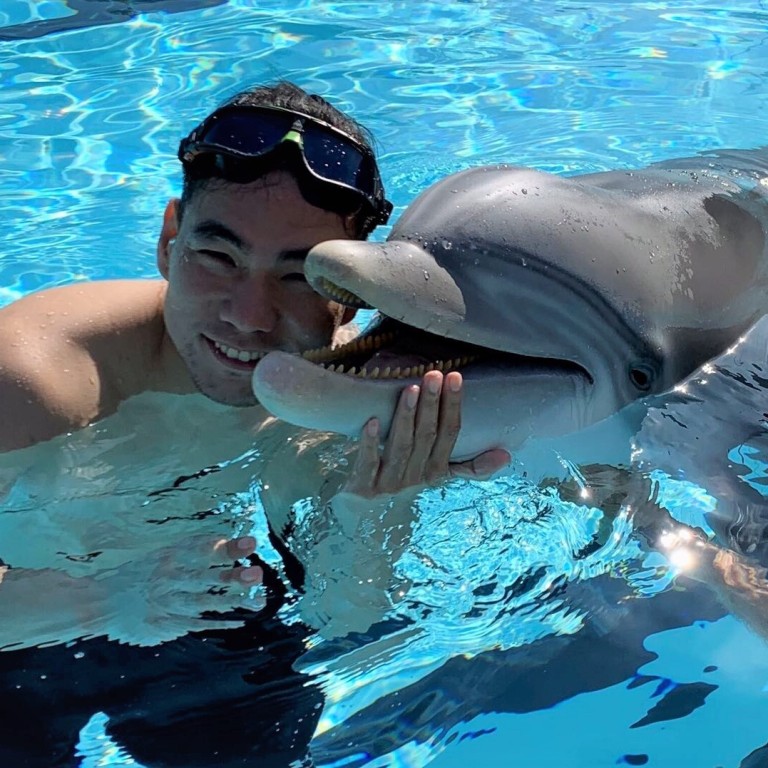
Chinese aquariums eye robotic dolphins amid ban on wildlife trade
- Two New Zealand tech entrepreneurs believe their animatronic creation could revolutionise the marine park industry
- A robotic dolphin costs between US$40-60 million, which the inventors say costs far less than what a traditional aquarium would pay to maintain real animals

To overcome their ethical dilemma, Wang and Melanie Langlotz, an augmented-reality gaming expert, decided to build their own robotic marine animal. They sought the expertise of two US animatronics experts, Roger Holzberg and Walt Conti, to realise their vision.
Holzberg, a former vice-president and creative director for Walt Disney Imagineering, told New Zealand media that the first 270kg prototype had a battery life of 10 hours and could last in saltwater for 10 years.
“This dolphin weighs, feels and has been engineered to simulate everything from the skeletal structure, to the muscular interaction with that skeletal structure, to the fat bladders and weight deposits on a real adolescent bottlenose dolphin,” Holzberg said in an RNZ interview.
Wang said the aim of the robots was to provide audiences with a “Hollywood blockbuster-style” experience.
Ranging from some US$40 million to US$60 million each, the first robotic dolphin is expected to be delivered in about two years.
Wang said the use of animatronic marine mammals had some economic advantages over live animals.
“In terms of a 10-year business operating period and a 2 million annual visitor capacity, the overall investment and maintenance costs for a decent animatronics entertainment portfolio only accounts for about one quarter or no more than one-third of what a traditional aquarium spends,” he said.
A robot that mimics a real animal ... allows for humans to interact and learn about an animal without having the animal imprisoned for human benefit.
Two South Africa-based animal rights groups, Ban Animal Trading (BAT) and EMS Foundation, released a report this month revealing that at least 5,035 live wild animals were exported from South Africa to China between 2016 and 2019.
Prathna Singh, director of BAT, gave the invention the nod and said the use of robotic dolphins was a “huge positive step in the direction of ethical entertainment and education”.
He believed that similar inventions could curb illegal wildlife trade. “These facilities, and others similar to them, would not have a need to purchase live animals and would then not contribute to the wildlife trade.”

01:35
Thailand sees record sea turtle hatchlings as coronavirus pandemic clears tourists from beaches
Lucas Tok, lecturer at the Marketing Section of Singapore Polytechnic’s School of Business, said: “Much of the captivation with live animals is the unpredictability in their behaviour and consumers are generally drawn to this, which is why they visit a zoo or safari multiple times in a single lifetime.”
However, if zoos are able to implement robotic dolphins in a way where every encounter with the dolphin is different, then the model could be sustainable in the long run. “It could be a positive nod towards dolphin education and conservation of their natural environment if an approach similar to this is taken,” Tok said.
China bans trade, eating of wild animals in battle against coronavirus
Echoing similar views, Singh said: “A robot that mimics a real animal in terms of look, feel, movement and behaviour allows for humans to interact and learn about an animal without having the animal imprisoned for human benefit.”
Singh suggested that more theme parks should consider adopting the use of a nonliving alternative, so that live animals in entertainment could be “a thing of the past”.
Tok said that with heightened concerns from the consumer market over the past decade, an overhaul of the marine captivity industry could be possible.
However, this would vary across different countries and the views that drive their habits, he said.
Help us understand what you are interested in so that we can improve SCMP and provide a better experience for you. We would like to invite you to take this five-minute survey on how you engage with SCMP and the news.

